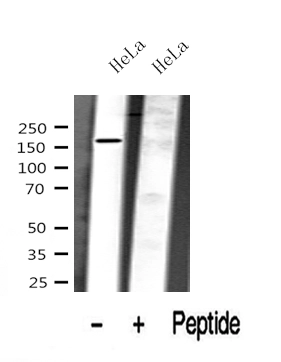
WB analysis of HeLa cell lysate using GTX04326 DEPDC5 antibody. The lane on the right was treated with blocking peptide.
DEPDC5 antibody
GTX04326
Overview
- SupplierGeneTex
- Product NameDEPDC5 antibody
- Delivery Days Customer9
- Application Supplier NoteWB: 1:1000-1:3000. *Optimal dilutions/concentrations should be determined by the researcher.Not tested in other applications.
- ApplicationsWestern Blot
- CertificationResearch Use Only
- ClonalityPolyclonal
- Concentration1 mg/ml
- ConjugateUnconjugated
- Gene ID9681
- Target nameDEPDC5
- Target descriptionDEP domain containing 5, GATOR1 subcomplex subunit
- Target synonymsDEP domain-containing protein 5; DEP.5; FFEVF; FFEVF1; GATOR complex protein DEPDC5
- HostRabbit
- IsotypeIgG
- Protein IDO75140
- Protein NameGATOR complex protein DEPDC5
- Scientific DescriptionThis gene encodes a member of the IML1 family of proteins involved in G-protein signaling pathways. The mechanistic target of rapamycin complex 1 (mTORC1) pathway regulates cell growth by sensing the availability of nutrients. The protein encoded by this gene is a component of the GATOR1 (GAP activity toward Rags) complex which inhibits the amino acid-sensing branch of the mTORC1 pathway. Mutations in this gene are associated with autosomal dominant familial focal epilepsy with variable foci. A single nucleotide polymorphism in an intron of this gene has been associated with an increased risk of hepatocellular carcinoma in individuals with chronic hepatitis C virus infection. Alternative splicing results in multiple transcript variants. [provided by RefSeq, Mar 2014]
- ReactivityHuman
- Storage Instruction-20°C or -80°C,2°C to 8°C
- UNSPSC12352203
